MARC Train: Difference between revisions
→Locomotives: + (edited with ProveIt) |
Cyberbot II (talk | contribs) Rescuing 1 sources, flagging 0 as dead, and archiving 23 sources. (Peachy 2.0 (alpha 8)) |
||
| Line 59: | Line 59: | ||
In 1976 MDOT entered into a similar agreement with Conrail, which had ended up with responsibility for local passenger train operations in the Northeast Corridor after the bankruptcy of Penn Central and other Northeast railroads. In that same year, the [[State Railroad Administration (Maryland)|State Railroad Administration]] was established by Executive Order of the [[Governor of Maryland|Governor]], to oversee these railroad contracts, to procure the needed rolling stock, to apply for and manage federal funding for the commuter rail service, and to administer a state funded subsidy program for [[Short-line railroad|shortline]] [[Freight rail transport|freight rail]] operations, primarily on the [[Eastern Shore of Maryland|Eastern Shore]] and in Western Maryland. |
In 1976 MDOT entered into a similar agreement with Conrail, which had ended up with responsibility for local passenger train operations in the Northeast Corridor after the bankruptcy of Penn Central and other Northeast railroads. In that same year, the [[State Railroad Administration (Maryland)|State Railroad Administration]] was established by Executive Order of the [[Governor of Maryland|Governor]], to oversee these railroad contracts, to procure the needed rolling stock, to apply for and manage federal funding for the commuter rail service, and to administer a state funded subsidy program for [[Short-line railroad|shortline]] [[Freight rail transport|freight rail]] operations, primarily on the [[Eastern Shore of Maryland|Eastern Shore]] and in Western Maryland. |
||
In 1982, [[United States Congress|Congress]] relieved Conrail of the responsibility to operate local passenger rail service, and in 1983, the State entered into an operating agreement with Amtrak to continue this service (now referred to as the Penn Line). The same year Maryland, along with a number of other Northeastern states, took control of its commuter railroads and the "MARC" (Maryland Area Rail Commuter) service name was established. The State Railroad Administration conducted a marketing study, which resulted in the creation of the name and logo of MARC to use as a unifying tool for marketing the service where, at that time, train crews wore either B&O or Amtrak uniforms, and some of the rail cars in use were leased from [[New Jersey Transit]]. In 1992, the former State Railroad Administration was merged with the Mass Transit Administration. The Mass Transit Administration was later renamed to [[Maryland Transit Administration]] which now oversees the operation of MARC Train Service.<ref>[http://mtamaryland.com/about/transitprofiles/MARC_History.cfm MARC History on MTA website]{{ |
In 1982, [[United States Congress|Congress]] relieved Conrail of the responsibility to operate local passenger rail service, and in 1983, the State entered into an operating agreement with Amtrak to continue this service (now referred to as the Penn Line). The same year Maryland, along with a number of other Northeastern states, took control of its commuter railroads and the "MARC" (Maryland Area Rail Commuter) service name was established. The State Railroad Administration conducted a marketing study, which resulted in the creation of the name and logo of MARC to use as a unifying tool for marketing the service where, at that time, train crews wore either B&O or Amtrak uniforms, and some of the rail cars in use were leased from [[New Jersey Transit]]. In 1992, the former State Railroad Administration was merged with the Mass Transit Administration. The Mass Transit Administration was later renamed to [[Maryland Transit Administration]] which now oversees the operation of MARC Train Service.<ref>[http://mtamaryland.com/about/transitprofiles/MARC_History.cfm MARC History on MTA website] {{wayback|url=http://mtamaryland.com/about/transitprofiles/MARC_History.cfm |date=20100117174532 }}</ref> |
||
Operating and maintenance responsibility for the Camden and Brunswick Lines was transferred from CSXT to Bombardier Transportation Services USA Corporation (BTS), a subsidiary of the [[Canada|Canadian]] company [[Bombardier Transportation]], effective 12:01 a.m. on June 29, 2013. BTS crews started operating MARC trains on Monday, July 1, 2013. CSXT continues to dispatch MARC Camden and Brunswick Line trains after transition on behalf of the MTA. |
Operating and maintenance responsibility for the Camden and Brunswick Lines was transferred from CSXT to Bombardier Transportation Services USA Corporation (BTS), a subsidiary of the [[Canada|Canadian]] company [[Bombardier Transportation]], effective 12:01 a.m. on June 29, 2013. BTS crews started operating MARC trains on Monday, July 1, 2013. CSXT continues to dispatch MARC Camden and Brunswick Line trains after transition on behalf of the MTA. |
||
Revision as of 16:34, 19 October 2015
| Maryland Area Regional Commuter Rail | |||
|---|---|---|---|
 | |||
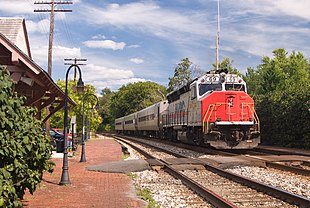 A MARC train on the Brunswick Line at Dickerson Station | |||
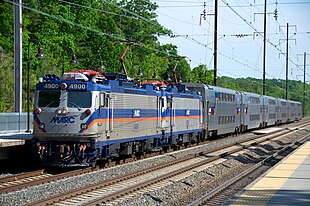 A MARC train with bi-levels on the Penn Line at BWI | |||
| Overview | |||
| Owner | Maryland Transit Administration | ||
| Locale | Baltimore-Washington Metropolitan Area | ||
| Transit type | Regional/ commuter rail | ||
| Number of lines | 3 | ||
| Number of stations | 42 | ||
| Daily ridership | 33,696 [1] | ||
| Chief executive | John Hovatter | ||
| Website | MARC Train official page | ||
| Operation | |||
| Began operation | 1984 | ||
| Operator(s) | Bombardier Transportation (Camden and Brunswick) Amtrak (Penn) (under contract to the Maryland Transit Administration) | ||
| Reporting marks | MARC | ||
| Infrastructure manager(s) | Amtrak CSX Transportation | ||
| Technical | |||
| System length | 187 mi (301 km) | ||
| Track gauge | 4 ft 8+1⁄2 in (1,435 mm) (standard gauge) | ||
| Electrification | 25Hz AC on the Penn Line | ||
| Top speed | 125 mph (201 km/h) | ||
| |||
MARC (Maryland Area Regional Commuter) Train Service[2] (reporting mark MARC), known prior to 1984 as Maryland Rail Commuter, is a commuter rail system comprising three lines in the Baltimore-Washington Metropolitan Area. MARC is administered by the Maryland Transit Administration (MTA), a Maryland Department of Transportation (MDOT) agency, and is operated under contract by Bombardier Transportation Services USA Corporation (BTS) and Amtrak over tracks owned by CSX Transportation (CSXT) and Amtrak.
With some equipment capable of reaching speeds of 125 miles per hour (201 km/h), MARC is purported to be the fastest commuter railroad in the United States.[3]
Train lines
MARC operates 93 trains on a typical weekday over three separate lines of service: the Brunswick Line (18 trains/19 trains on Fridays),[4] the Camden Line (21 trains),[5] and the Penn Line (57 trains).[6] MARC added limited weekend service on the Penn Line on December 7, 2013.[7] Service is suspended or reduced on selected Federal holidays.
Brunswick Line
The Brunswick Line runs about 74 miles (119 km) from Washington, D.C. to Martinsburg, W.Va over the CSXT Metropolitan and Cumberland Subdivisions (both former Baltimore and Ohio Railroad (B&O) lines), and the Amtrak Washington Terminal District. The Brunswick Line service also includes a 14 miles (23 km) branch serving Frederick which diverges from the Metropolitan Subdivision at East Rocks (just east of Point of Rocks) before traveling over the CSXT Old Main Line and the MDOT Frederick Branch.
Camden Line
The Camden Line runs about 39 miles (63 km) between Washington, D.C. and Camden Station in Baltimore over the CSXT Capital Subdivision and Amtrak Washington Terminal District. The B&O first began service over portions of this route in 1830, making it one of the oldest passenger rail lines in the U.S. still in operation.[8]
Penn Line
The Penn Line runs about 77 miles (124 km) between Washington, D.C. and Perryville, Maryland via Baltimore Penn Station over Amtrak's Northeast Corridor and Washington Terminal District. It is purported to be the fastest commuter rail line in North America, with trains of bi-level cars and electric locomotives capable of operating at speeds up to 125 miles per hour (201 km/h).[3] The service was initially operated by the Pennsylvania Railroad (hence the name) and is the busiest line, carrying more passengers than the other two lines combined. The Penn Line is the only line that operates on weekends.
- Special Western Maryland service
Trains have made special weekend trips to and from Cumberland, Maryland. Past events have included trains for Western Maryland residents to attend sporting events in the Baltimore/Washington area, such as Baltimore Orioles or Washington Redskins games, or for Baltimore/Washington residents to attend Railfest in Cumberland and enjoy the scenic mountains and fall foliage of Western Maryland.[9]
History

Passenger service along the modern-day MARC route began on May 24, 1830, with the first Baltimore & Ohio Railroad (B&O) passenger train from Mt. Claire Station in Baltimore to Ellicott City. The train traveled the route of the current MARC Camden Line from Lansdowne to St. Denis. During the mid to late 19th Century, B&O passenger service was extended to Washington DC and over the current MARC Brunswick Line to Martinsburg. Service on the current MARC Penn Line originated during the same period as the local train service of the Pennsylvania Railroad, which was later succeeded along the same route by Penn Central and Conrail service.
The passenger trains eventually became unprofitable, and in 1974, the B&O Railroad approached the State of Maryland with an intention of discontinuing the service unless a subsidy could be provided. The Maryland Department of Transportation (MDOT) agreed to provide a partial subsidy of the deficit in 1974, and in 1975 this evolved into an operating agreement with the B&O, where Maryland agreed to pay the total operating deficit for the trains and provide the rolling stock.
In 1976 MDOT entered into a similar agreement with Conrail, which had ended up with responsibility for local passenger train operations in the Northeast Corridor after the bankruptcy of Penn Central and other Northeast railroads. In that same year, the State Railroad Administration was established by Executive Order of the Governor, to oversee these railroad contracts, to procure the needed rolling stock, to apply for and manage federal funding for the commuter rail service, and to administer a state funded subsidy program for shortline freight rail operations, primarily on the Eastern Shore and in Western Maryland.
In 1982, Congress relieved Conrail of the responsibility to operate local passenger rail service, and in 1983, the State entered into an operating agreement with Amtrak to continue this service (now referred to as the Penn Line). The same year Maryland, along with a number of other Northeastern states, took control of its commuter railroads and the "MARC" (Maryland Area Rail Commuter) service name was established. The State Railroad Administration conducted a marketing study, which resulted in the creation of the name and logo of MARC to use as a unifying tool for marketing the service where, at that time, train crews wore either B&O or Amtrak uniforms, and some of the rail cars in use were leased from New Jersey Transit. In 1992, the former State Railroad Administration was merged with the Mass Transit Administration. The Mass Transit Administration was later renamed to Maryland Transit Administration which now oversees the operation of MARC Train Service.[10]
Operating and maintenance responsibility for the Camden and Brunswick Lines was transferred from CSXT to Bombardier Transportation Services USA Corporation (BTS), a subsidiary of the Canadian company Bombardier Transportation, effective 12:01 a.m. on June 29, 2013. BTS crews started operating MARC trains on Monday, July 1, 2013. CSXT continues to dispatch MARC Camden and Brunswick Line trains after transition on behalf of the MTA.
Contract controversy
Beginning as early as June 2010, MARC began looking for a new operator to replace CSX Transportation for the Camden and Brunswick Lines.[11]
Controversy first arose when the French-owned and Montgomery County, Maryland-based Keolis (already operating Virginia Railway Express trains) was the only bidder for the contract. The bidding process was suspended in the fall of 2010 due to lack of competition. Before bidding reopened in 2011, Maryland passed a law (at the request of Leo Bretholz and other Holocaust survivors) requiring Keolis's majority owner, SNCF (currently solely owned by the French government)[12] to fully disclose its role in transporting Jews to concentration camps during World War II (while SNCF was under control of the Nazi government), to the satisfaction of the Maryland state archivist, before Keolis would be allowed to place a bid for MARC service. Keolis faced similar issues while bidding for VRE operations in 2009, but in the end, they were allowed to run VRE.
Keolis and SNCF lawyers claim that the all documentation required by the law had been produced long before.[13] This was also asserted by Don Phillips in the July 2011 issue of Trains Magazine. Phillips states that a full 914 page independent report and complete history of SNCF's role in the Holocaust, released in 1996, is currently being translated into English.[14] Phillips cites from the publicly available English introduction to the report, noting that while some SNCF workers worked with the Nazis, acts of sabotage were frequent, and the Nazis shot 819 SNCF workers for refusing to carry out the rail orders of the government. An additional 1200 railway workers were themselves sent to concentration camps over SNCF rails. Phillips also notes that SNCF does business with the Israel rail system and works without government prompting to educate the current generation about the war and Holocaust.
As of June, 2011, the future of Keolis's ability to bid on the MARC contract remained up in the air with the new disclosure law in place. No other bidder had emerged to replace CSXT. On June 5, 2011, the Washington Post ran an editorial critical of the disclosure law. The Post claimed that SNCF has been working for years on digitizing its records, and the Maryland law may require items or formats counter to SNCF's current system and/or French law. The Post also reported that some in the Maryland Attorney General's Office worried the law was not Constitutional, may risk retaliation towards Maryland firms overseas, and may risk federal funding for Maryland "by imposing arbitrary procurement demands on a single company."[15][16]
MTA issued a new Request for Proposals for the operations and maintenance of MARC services on the Brunswick and Camden Lines on July 14, 2011 with a deadline for proposals on November 21, 2011.[17] On October 17, 2012, a $204 million contract to run the CSXT lines was awarded to the Canadian company Bombardier Transportation,[18] effectively ending the Keolis controversy. The pre-service transition period began on the Thursday of that week, during which time CSXT continued to operate MARC trains.[18][19]
Equipment
Locomotives
| Manufacturer | Model | Quantity | Locomotive Numbers | Notes | |
|---|---|---|---|---|---|
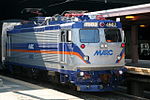
|
EMD/ASEA | AEM-7 | 4 | 4900–4903 |
|

|
Bombardier-Alstom | HHP-8 | 6 | 4910–4915 |
|

|
EMD | GP39H-2 | 6 | 70–75 |
|
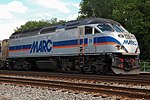
|
MPI | MP36PH-3C | 26 | 10–35 |
|
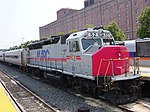
|
EMD | GP40WH-2 | 1 | 68 |
As the Penn Line is the only electrified line, the AEM-7 and HHP-8 are restricted to that line.
In spring 2008 MARC placed an order for 26 new MPI MP36PH-3C diesel locomotives, which replaced all 19 of the 70s-era GP40WH-2 units. They began arriving in November 2008.[22] All are in service as of March 2011; however, MARC still uses a single GP40WH-2 unit occasionally as a need arises. (Such as when an Amtrak or MARC train malfunctions)
Due to the fact that as of June 2016, Amtrak will no longer provide maintenance service for MARC equipment, MARC announced plans in August 2015 to seek funding to procure eight Siemens Charger diesel locomotives to replace its fleet of electric locomotives. They would be attached to an existing order from the Illinois Department of Transportation, in order to take advantage of savings from a larger order than a MARC-only contract, and are planned to be delivered in fall of 2017.[23] In September, the Maryland Board of Public Works approved a $58.1 million contract for the locomotives and associated costs.[24]
Passenger cars
| Manufacturer / Model | Quantity | Delivered | Car Numbers | Notes | ||
|---|---|---|---|---|---|---|

|
Sumitomo/ Nippon Sharyo MARC II |
60 |
26 MARC IIA
|
1985–1987 | 7700-7715 7745-7756 |
|
|
34 MARC IIB
|
1991–1993 | 7716-7735 7757-7762 7791-7799 |
| |||

|
Kawasaki MARC III |
63 |
|
1999–2001 | 7800-7834 7845-7858 7870-7876 7890-7896 |
|
| Pullman MARC Gallery |
12 |
|
2004 | 7900-7911 |
| |
| Bombardier MARC IV |
54 |
|
2014–2015 | 8000- |
| |
While many consists on all three lines are mixed with single- and bi-level cars, the majority of rush hour trains on the Penn Line are composed mainly of Kawasaki bi-levels, while trains on the Brunswick Line and the Camden Line use more single levels (particularly for shorter 3-4 car trains). The Pullman gallery cars are operated only on Brunswick Line trains to Brunswick or Martinsburg due to their restriction to use at low-level platforms only. Like most other commuter rail systems in North America, all trains are operated with a cab car from which the engineer can control the train. The cab car is typically at the head of trains traveling toward Washington to keep diesel fumes away from the terminal. To accommodate elevation gains, the locomotive is at the head of trains heading away from Washington. In the early 2000s a single unpowered EMD F cab unit, #7100 (ex-Baltimore & Ohio Railroad F7 #4553), occasionally substituted for a cab car. In addition to serving as a Non-Powered Control Unit, the unit is also outfitted with a head-end power generator to supply electricity to the train.[25]
To cope with increasing ridership, the MTA announced in August 2008 the acquisition of 13 Kawasaki bi-level passenger cars from VRE, originally scheduled to be placed in service by November 2008. The first units were placed in service in mid-January 2009 on the Brunswick line. The MTA has announced that all 13 cars will be placed in service on the Brunswick Line to replace the aging ex-Metra gallery cars.[26] These units have seats with a slightly different design facing towards the center of the cars (as opposed to facing the ends as on the original MARC cars). The ex-VRE cab cars (7855-7858) also use conventional ditch lights as opposed to the gyra lights used on the original MARC III cab cars. The $22 million purchase is a 10% increase in fleet size from 122 passenger cars.[26] However, due to an increase in ridership, the ex-Metra cars have remained in service along the Brunswick Line and the ex-VRE cars operate across all 3 lines.
In 2011 MARC ordered 54 new bi-levels from Bombardier to increase capacity. The cars were purchased using an un-exercised option from NJ Transit. The MARC order consists of 39 trailers and 15 cab cars. The cars will replace the MARC IIA single level cars and gallery cars, resulting in a net increase of 16 cars. Delivery is scheduled to begin in 2013.[27]
Incidents
1996

On February 16, 1996, during the Friday evening rush hour, an eastbound train headed to Washington Union Station via the Brunswick Line collided with the westbound Amtrak Capitol Limited headed to Chicago via Pittsburgh. The collision occurred at Georgetown Junction on a snow-swept stretch of track just west of Silver Spring, Maryland. The crash left 11 people dead aboard the MARC train. Three died of injuries suffered in the impact alone, with the rest succumbing to the ensuing smoke and flames or a combination of the two. Engineer Ricky Orr and conductors Jimmy Major Jr. and Jim Quillen were among the victims. Eight Jobs Corps students also were killed during the accident.
The NTSB report concluded that the MARC crew apparently forgot the approach signal aspect of the Kensington color-position signal after making a flag stop at Kensington Station. The MARC train was operating in push mode with the cab control car out front. The Amtrak locomotives were in the crossover at the time of the collision; the MARC cab control car collided with the lead Amtrak unit, F40PH #255, rupturing its fuel tank and igniting the fire that caused most of the casualties. The second unit was a GE Genesis P40DC #811, a newer unit that has a fuel tank that is shielded in the center of the frame. The official investigation also suggests that the accident might have been prevented if a human-factors analysis had been conducted when modifications to the track signaling system were made in 1992 with the closing of nearby QN tower.
2008
On February 7, 2008 a train derailed at Union Station after it was hit by an Amtrak switcher locomotive. The train was still unloading passengers at the time of impact, and seven people received minor head and neck injuries. The Amtrak locomotive was attempting to couple to the train and was reportedly moving too fast.[citation needed]
2010
Two significant events in 2010 received official response.
On June 21, 2010, northbound Amtrak-operated Penn Line train 538 broke down at 6:23 p.m. Temperatures inside the train reached 100 degrees due to malfunctioning air conditioning. After passengers called 911, 10 people were treated at the scene for heat-related problems. All passengers were cleared from the scene by 9:40pm.[28] This incident prompted MDOT Secretary Beverley Swaim-Staley to apologize to customers aboard Penn Line train 538 on June 27, 2010.
On June 28, an Amtrak engineer operating a MARC train overran a scheduled stop in Odenton, without notice to passengers. Secretary Swaim-Staley was aboard the train at the time, and issued public statements about the situation. Amtrak CEO Joseph H. Boardman apologized to riders the following morning.
This pair of events prompted Amtrak to draft an emergency response plan for broken down MARC trains.[29]
Proposed service expansion
In the first decade of the 21st century ridership increased significantly, and the system neared capacity for its current configuration. With the area population growing and the BRAC process poised to bring new jobs to Aberdeen Proving Ground and Ft. Meade, both of which are served by nearby stations, the state saw the need to expand service to accommodate growth. In September 2007, MTA Maryland unveiled an ambitious 30-year plan of system improvements. Though funding sources had not been established at that time, the plan represented the state's goals of increasing capacity and flexibility. Proposed improvements included:[30]
- Acquisition of new equipment. 54 Bombardier MultiLevels were ordered to replace aging single-level cars.
- Weekend service on the Penn Line. Service began on December 7, 2013 between Baltimore and D.C., including several round trips going to Martin State Airport. There are 9 round trips on Saturday (3 to Martin State Airport) and 6 on Sunday (2 to Martin State Airport).[31]
- Increased mid-day service and reverse commute service on the Camden and Brunswick Lines. As of 2015, there is a somewhat limited reverse commute service in effect on the Camden Line.
- Extension of service past Union Station to L'Enfant and Northern Virginia along tracks used by VRE trains, thus relieving pressure on the Washington Metro.
- More daily trips east of Penn Station, including improved service to Aberdeen Proving Ground.
- Service beyond Perryville to Newark, Delaware or Wilmington, Delaware, providing a connection to SEPTA's regional rail services.
- New or expanded tunnels along the Northeast Corridor in Baltimore.
- New stations in Baltimore, providing direct connections with the Metro Subway, and service to Johns Hopkins Hospital and Bayview Medical Center.
- Rapid transit-like service through Baltimore.
While many of these proposals would require expensive capital improvement and years or decades to implement, the agency would like to put others into action as quickly as possible, suggesting that, for instance, Penn Line weekend service could have begun as early as 2008. However, budgetary issues have delayed any such expansions. In Spring 2009, to offset such budget shortfalls, ticket sales employees at most non-Amtrak stations were replaced with Amtrak "Quik-Trak" touchscreen ticket machines, and some train services have been eliminated or scaled back. For example, Train 871, the 1:30pm train on the Brunswick line, now operates only on Fridays. Ticket machines were also added to stations that were not previously staffed, such as Halethorpe. The only remaining staffed stations, Odenton and Frederick, are staffed by Commuter Direct.[32][33]
References
- ^ "MTA Maryland 2012 Annual Report" (PDF). MTA Maryland. September 2013. Retrieved 2013-10-10.
- ^ "Transit Information Overview". Maryland Transit Administration. Retrieved 2011-06-24.
- ^ a b Matt Van Hatten (June 30, 2006). "Maryland Rail Commuter (MARC)". Trains Magazine. Retrieved 2010-02-16.
- ^ "MARC Brunswick Line Timetable" (PDF). MTA Maryland. January 14, 2013. Retrieved 2013-02-13.
- ^ "MARC Camden Line Timetable" (PDF). MTA Maryland. March 9, 2015. Retrieved 2015-03-24.
- ^ "MARC Penn Line Timetable" (PDF). MTA Maryland. April 2, 2012. Retrieved 2013-02-13.
- ^ Yvonne Wenger and Natalie Sherman (December 7, 2013). "MARC train weekend service begins". The Baltimore Sun. Retrieved 2013-12-08.
- ^ Dilts, James D. (1996). The Great Road: The Building of the Baltimore and Ohio, the Nation's First Railroad, 1828-1853. Palo Alto, CA: Stanford University Press. p. 157. ISBN 978-0-8047-2629-0.
- ^ Stakem, Patrick H. MARC, Maryland Area Rail Commuter, A Rider’s Guide, 2008, PRB Publishing, ASIN B004U7FKQS
- ^ MARC History on MTA website Archived 2010-01-17 at the Wayback Machine
- ^ "MARC to seek new operator for CSX-run routes". Trains Magazine. 14 June 2010. Retrieved 14 June 2010.
- ^ Shaver, Katherine (July 7, 2010). "Holocaust group faults VRE contract". The Washington Post.
- ^ "No way to run a railroad". WBAL TV. 2011-03-03. Retrieved 2012-09-01.
- ^ Phillips, Don. "Lawsuits, Commuter Trains and the Holocaust." Trains July 2011: P. 11.
- ^ Lind, Michael (June 5, 2011). "No way to run a railroad". The Washington Post.
- ^ Rubin, Neil (February 10, 2012). "State archivist SNCF archives might not be enough". Baltimore Jewish Times.
- ^ Sohr, Nicholas (November 21, 2011). "MD MTA Keolis mum on bids to run MARC lines". The Daily Record via masstransitmag.com.
- ^ a b Weir, Kytja (17 October 2012). "Bombardier wins $204m MARC commuter train contract". The Washington Examiner. Retrieved 28 October 2012.
- ^ Shaver, Katherine (17 October 2012). "New company to operate some MARC trains". The Washington Post. Retrieved 18 December 2012.
- ^ "Video showing MARC 68 Going to help out" (Video). bebo2good1. September 2012. Retrieved 2012-09-01.
- ^ "Marc Penn line 421 Description" (Website). MTA Maryland. November 2012. Retrieved 2012-11-02.
- ^ "MTA Expands MARC Penn Line Service". MTA Maryland Service Information. Retrieved 2010-02-16.
- ^ Dresser, Michael (August 8, 2015). "MTA seeks $58 million for new MARC engines". The Baltimore Sun. Retrieved 10 August 2015.
- ^ "Maryland Board of Public Works approves contract for MARC locomotives". Railway Age. 18 September 2015. Retrieved 22 September 2015.
- ^ "The MARC 7100 Returns! (NOV. 99 CSX Railfan Magazine)". Trainweb.org. Retrieved 2012-09-01.
- ^ a b Michael Dresser (2008-08-20). "New cars may ease MARC crowding". The Baltimore Sun. pp. 1B, 6B.
- ^ "GOVERNOR O'MALLEY ANNOUNCES MARC TO PURCHASE 54 MULTI-LEVEL PASSENGER CARS". MTA Maryland. 2011-11-02. Retrieved 2012-09-01.
- ^ Shaver, Katherine (June 23, 2010). "900 riders stuck on MARC train for more than two hours with no air conditioning". The Washington Post. Retrieved 2010-06-30.
- ^ Shaver, Katherine (July 1, 2010). "Amtrak unveils plan to dispatch help when MARC trains break down". The Washington Post. ISSN 0740-5421. Retrieved 2010-07-07.
- ^ "MARC Growth & Investment Plan" (PDF). MTA Maryland. September 2007. Retrieved 2010-02-16.
- ^ "Penn Line Weekend Schedule" (PDF). MTA Maryland. September 2013. Retrieved 2013-09-24.
- ^ "Odenton station is now a Commuter Direct Store". MTA Maryland. September 2009.
- ^ "Commuter Direct Store Locations". Commuter Direct. March 2015.
External links
- Maryland Area Regional Commuter trains
- United States regional rail systems
- Railway services introduced in 1984
- Maryland railroads
- Washington, D.C. railroads
- Maryland Transit Administration
- Passenger rail transportation in Maryland
- Passenger rail transportation in Washington, D.C.
- Standard gauge railways in the United States

